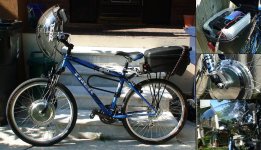kwilson115
1 µW
- Joined
- Oct 18, 2009
- Messages
- 4
Hello All,
I am wanting to convert to an E-bike. However I have some questions. Please bear with me or the noob stuff.
ME: I am 46 yrs old in reasonable shape, I plan on using this bike as a work commute only.
Commute: 13 miles one way, level ground, lots of stop and go (Detroit area suburb).
Bikes to choose from: 1996 Raleigh MTN bike or 2002 Gary Fisher both w/ 26" wheels.
My questions...
Which drive, front wheel or rear wheel.?
Voltage, 24, 36 or 48.? ( I want to sustain at least 20mph, with 30% pedal only, and don't have to charge it for return trip)
Manufacture, why and what motor.?
Battery, Technology and setup. ( I have seen a video where a guy uses dewalt cordless tool Lithium ion batteries)
and any thing else I may have missed .
Thanks in Advance for Your answers and Your Patience in the Questions I'll will ask Later.
ken
I am wanting to convert to an E-bike. However I have some questions. Please bear with me or the noob stuff.
ME: I am 46 yrs old in reasonable shape, I plan on using this bike as a work commute only.
Commute: 13 miles one way, level ground, lots of stop and go (Detroit area suburb).
Bikes to choose from: 1996 Raleigh MTN bike or 2002 Gary Fisher both w/ 26" wheels.
My questions...
Which drive, front wheel or rear wheel.?
Voltage, 24, 36 or 48.? ( I want to sustain at least 20mph, with 30% pedal only, and don't have to charge it for return trip)
Manufacture, why and what motor.?
Battery, Technology and setup. ( I have seen a video where a guy uses dewalt cordless tool Lithium ion batteries)
and any thing else I may have missed .
Thanks in Advance for Your answers and Your Patience in the Questions I'll will ask Later.
ken


